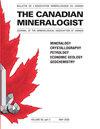俄罗斯乌拉尔南部米亚斯砂矿带铂族矿物Cu2RhIrSb2的一个新种
IF 1.5
4区 地球科学
Q3 MINERALOGY
引用次数: 0
摘要
Fleetite,Cu2RhIrSb2是一种新的铂族矿物(PGM),在俄罗斯乌拉尔南部的Miass Placer带(Au–PGE)与Os–Ir–Ru合金共生发现。发现了直径为50μm的单个晶粒。锇、钌和铱是主要的伴生矿物;还存在Pt–Fe合金、月桂矿、富Sb的Irersite、富Rh的Tolovite、钙石、安多岩、镍铁铂、黑兹伍德岩、含PGE的pentlandite和正长岩,以及镁橄榄石(Fo93.7)、铬铁矿-镁铬铁矿和富Mg的edenite的微米包裹体。在反射光中,褐铁矿呈浅灰色;它是不透明的、各向同性的、非多色的和非双反射的。我们报告在空气中测量的反射率值。七点分析(波长色散光谱法)的平均值给出了Cu 13.93,Ni 8.60,Fe 0.10,Ir 28.07,Rh 7.91,Ru 1.96,Sb 39.28,总重量百分比为99.85,对应于(Cu1.41Ni0.58Fe0.01)∑2.00(Rh0.49Ni0.36Ru0.12)∑0.97Ir0.95Sb2.08,基于每个分子式单元六个原子,考虑到结构结果。计算出的密度为10.83 g/cm3。单晶X射线研究表明,羊毛岩为立方晶系,空间群Fdm(#227),a=111.6682(8)Å,V=1158.59(19)Å3,Z=16。对X射线粉末衍射数据进行最小二乘细化,得到A=11.6575(5)Å和V=1584.22(19)Å3。粉末图案中最强的五次反射[dinÅ(I)(hkl)]分别为:6.70(75)(111)、4.13(100)(220)、3.52(30)(311)、2.380(50)(422)、2.064(40)(440)。根据Fo>4σ(Fo)的153次反射,求解出了羊毛岩的晶体结构,并将其细化为R=0.0340。它与Pd11Bi2Se2是同型的,最好描述为金属间化合物,所有金属原子都处于12倍配位。在冷却蛇绿岩烃源岩中,伴生合金相与循环中富含Sb、As和S的流体相反应,形成了辉橄榄岩和其他晚期奇异相。该矿物以迈克尔·E·弗利特(1938–2017)的名字命名,以表彰他对地球科学的重大贡献。本文章由计算机程序翻译,如有差异,请以英文原文为准。
Fleetite, Cu2RhIrSb2, a New Species of Platinum-Group Mineral from the Miass Placer Zone, Southern Urals, Russia
Fleetite, Cu2RhIrSb2, a new species of platinum-group mineral (PGM), was discovered intergrown with an Os–Ir–Ru alloy in the Miass Placer Zone (Au–PGE), southern Urals, Russia. A single grain 50 μm across was found. Osmium, ruthenium, and iridium are the main associated minerals; also present are Pt–Fe alloys, laurite, Sb-rich irarsite, Rh-rich tolovkite, kashinite, anduoite, ferronickelplatinum, heazlewoodite, PGE-bearing pentlandite and digenite, as well as micrometric inclusions of forsterite (Fo93.7), chromite–magnesiochromite, and Mg-rich edenite. In reflected light, fleetite is light gray; it is opaque, isotropic, non-pleochroic, and non-bireflectant. We report reflectance values measured in air. A mean of seven point-analyses (wavelength-dispersive spectrometry) gave Cu 13.93, Ni 8.60, Fe 0.10, Ir 28.07, Rh 7.91, Ru 1.96, Sb 39.28, total 99.85 wt.%, corresponding to (Cu1.41Ni0.58Fe0.01)Σ2.00(Rh0.49Ni0.36Ru0.12)Σ0.97Ir0.95Sb2.08 on the basis of six atoms per formula unit, taking into account the structural results. The calculated density is 10.83 g/cm3. Single-crystal X-ray studies show that fleetite is cubic, space group Fdm (#227), a = 11.6682(8) Å, V = 1588.59(19) Å3, and Z = 16. A least-squares refinement of X-ray powder-diffraction data gave a = 11.6575(5) Å and V = 1584.22(19) Å3. The strongest five reflections in the powder pattern [d in Å(I)(hkl)] are: 6.70(75)(111), 4.13(100)(220), 3.52(30)(311), 2.380(50)(422), 2.064(40)(440). Results of synchrotron micro-Laue diffraction experiments are consistent [a = 11.66(2) Å]. The crystal structure of fleetite was solved and refined to R = 0.0340 based upon 153 reflections with Fo > 4σ(Fo). It is isotypic with Pd11Bi2Se2 and best described as intermetallic, with all metal atoms in 12-fold coordination. Fleetite and other late exotic phases were formed by reaction of the associated alloy phases with a fluid phase enriched in Sb, As, and S in circulation in the cooling ophiolite source-rock. The mineral is named after Michael E. Fleet (1938–2017) in recognition of his significant contributions to the Earth Sciences.
求助全文
通过发布文献求助,成功后即可免费获取论文全文。
去求助
来源期刊

Canadian Mineralogist
地学-矿物学
CiteScore
2.20
自引率
22.20%
发文量
45
审稿时长
4-8 weeks
期刊介绍:
Since 1962, The Canadian Mineralogist has published papers dealing with all aspects of mineralogy, crystallography, petrology, economic geology, geochemistry, and applied mineralogy.
 求助内容:
求助内容: 应助结果提醒方式:
应助结果提醒方式:


